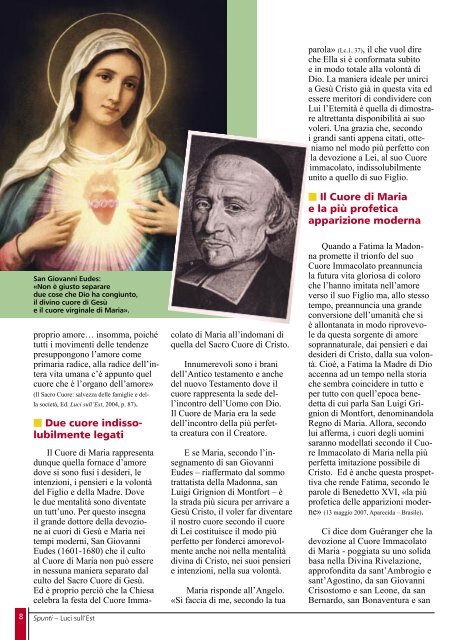Nel 50° della Consacrazione d'Italia al Cuore Immacolato di Maria
Nel 50° della Consacrazione d'Italia al Cuore Immacolato di Maria
Nel 50° della Consacrazione d'Italia al Cuore Immacolato di Maria
Create successful ePaper yourself
Turn your PDF publications into a flip-book with our unique Google optimized e-Paper software.
San Giovanni Eudes:<br />
«Non è giusto separare<br />
due cose che Dio ha congiunto,<br />
il <strong>di</strong>vino cuore <strong>di</strong> Gesù<br />
e il cuore virgin<strong>al</strong>e <strong>di</strong> <strong>Maria</strong>».<br />
proprio amore… insomma, poiché<br />
tutti i movimenti delle tendenze<br />
presuppongono l’amore come<br />
primaria ra<strong>di</strong>ce, <strong>al</strong>la ra<strong>di</strong>ce dell’intera<br />
vita umana c’è appunto quel<br />
cuore che è l’organo dell’amore»<br />
(Il Sacro <strong>Cuore</strong>: s<strong>al</strong>vezza delle famiglie e <strong>della</strong><br />
società, Ed. Luci sull’Est, 2004, p. 87).<br />
Due cuore in<strong>di</strong>ssolubilmente<br />
legati<br />
Il <strong>Cuore</strong> <strong>di</strong> <strong>Maria</strong> rappresenta<br />
dunque quella fornace d’amore<br />
dove si sono fusi i desideri, le<br />
intenzioni, i pensieri e la volontà<br />
del Figlio e <strong>della</strong> Madre. Dove<br />
le due ment<strong>al</strong>ità sono <strong>di</strong>ventate<br />
un tutt’uno. Per questo insegna<br />
il grande dottore <strong>della</strong> devozione<br />
ai cuori <strong>di</strong> Gesù e <strong>Maria</strong> nei<br />
tempi moderni, San Giovanni<br />
Eudes (1601-1680) che il culto<br />
<strong>al</strong> <strong>Cuore</strong> <strong>di</strong> <strong>Maria</strong> non può essere<br />
in nessuna maniera separato d<strong>al</strong><br />
culto del Sacro <strong>Cuore</strong> <strong>di</strong> Gesù.<br />
Ed è proprio perciò che la Chiesa<br />
celebra la festa del <strong>Cuore</strong> Imma-<br />
8 Spunti – Luci sull’Est<br />
colato <strong>di</strong> <strong>Maria</strong> <strong>al</strong>l’indomani <strong>di</strong><br />
quella del Sacro <strong>Cuore</strong> <strong>di</strong> Cristo.<br />
Innumerevoli sono i brani<br />
dell’Antico testamento e anche<br />
del nuovo Testamento dove il<br />
cuore rappresenta la sede dell’incontro<br />
dell’Uomo con Dio.<br />
Il <strong>Cuore</strong> de <strong>Maria</strong> era la sede<br />
dell’incontro <strong>della</strong> più perfetta<br />
creatura con il Creatore.<br />
E se <strong>Maria</strong>, secondo l’insegnamento<br />
<strong>di</strong> san Giovanni<br />
Eudes – riaffermato d<strong>al</strong> sommo<br />
trattatista <strong>della</strong> Madonna, san<br />
Luigi Grignion <strong>di</strong> Montfort – è<br />
la strada più sicura per arrivare a<br />
Gesù Cristo, il voler far <strong>di</strong>ventare<br />
il nostro cuore secondo il cuore<br />
<strong>di</strong> Lei costituisce il modo più<br />
perfetto per fonderci amorevolmente<br />
anche noi nella ment<strong>al</strong>ità<br />
<strong>di</strong>vina <strong>di</strong> Cristo, nei suoi pensieri<br />
e intenzioni, nella sua volontà.<br />
<strong>Maria</strong> risponde <strong>al</strong>l’Angelo.<br />
«Si faccia <strong>di</strong> me, secondo la tua<br />
parola» (Lc.1, 37), il che vuol <strong>di</strong>re<br />
che Ella si è conformata subito<br />
e in modo tot<strong>al</strong>e <strong>al</strong>la volontà <strong>di</strong><br />
Dio. La maniera ide<strong>al</strong>e per unirci<br />
a Gesù Cristo già in questa vita ed<br />
essere meritori <strong>di</strong> con<strong>di</strong>videre con<br />
Lui l’Eternità è quella <strong>di</strong> <strong>di</strong>mostrare<br />
<strong>al</strong>trettanta <strong>di</strong>sponibilità ai suo<br />
voleri. Una grazia che, secondo<br />
i gran<strong>di</strong> santi appena citati, otteniamo<br />
nel modo più perfetto con<br />
la devozione a Lei, <strong>al</strong> suo <strong>Cuore</strong><br />
immacolato, in<strong>di</strong>ssolubilmente<br />
unito a quello <strong>di</strong> suo Figlio.<br />
Il <strong>Cuore</strong> <strong>di</strong> <strong>Maria</strong><br />
e la più profetica<br />
apparizione moderna<br />
Quando a Fatima la Madonna<br />
promette il trionfo del suo<br />
<strong>Cuore</strong> <strong>Immacolato</strong> preannuncia<br />
la futura vita gloriosa <strong>di</strong> coloro<br />
che l’hanno imitata nell’amore<br />
verso il suo Figlio ma, <strong>al</strong>lo stesso<br />
tempo, preannuncia una grande<br />
conversione dell’umanità che si<br />
è <strong>al</strong>lontanata in modo riprovevole<br />
da questa sorgente <strong>di</strong> amore<br />
soprannatur<strong>al</strong>e, dai pensieri e dai<br />
desideri <strong>di</strong> Cristo, d<strong>al</strong>la sua volontà.<br />
Cioè, a Fatima la Madre <strong>di</strong> Dio<br />
accenna ad un tempo nella storia<br />
che sembra coincidere in tutto e<br />
per tutto con quell’epoca benedetta<br />
<strong>di</strong> cui parla San Luigi Grignion<br />
<strong>di</strong> Montfort, denominandola<br />
Regno <strong>di</strong> <strong>Maria</strong>. Allora, secondo<br />
lui afferma, i cuori degli uomini<br />
saranno mo<strong>della</strong>ti secondo il <strong>Cuore</strong><br />
<strong>Immacolato</strong> <strong>di</strong> <strong>Maria</strong> nella più<br />
perfetta imitazione possibile <strong>di</strong><br />
Cristo. Ed è anche questa prospettiva<br />
che rende Fatima, secondo le<br />
parole <strong>di</strong> Benedetto XVI, «la più<br />
profetica delle apparizioni moderne»<br />
(13 maggio 2007, Aparecida – Brasile).<br />
Ci <strong>di</strong>ce dom Guéranger che la<br />
devozione <strong>al</strong> <strong>Cuore</strong> <strong>Immacolato</strong><br />
<strong>di</strong> <strong>Maria</strong> - poggiata su uno solida<br />
basa nella Divina Rivelazione,<br />
approfon<strong>di</strong>ta da sant’Ambrogio e<br />
sant’Agostino, da san Giovanni<br />
Crisostomo e san Leone, da san<br />
Bernardo, san Bonaventura e san


